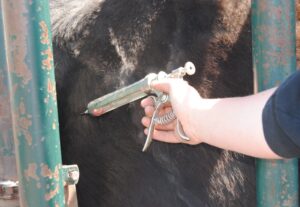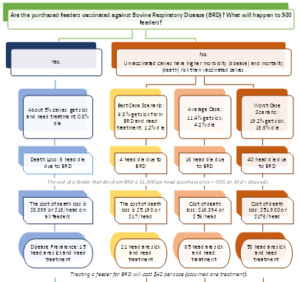The cost-benefit of using vaccines: bovine respiratory disease

Bovine respiratory disease (BRD) is one of the costliest health issues facing the beef industry today. While a lot of research on BRD has been focused at the feedlot stage, the disease is also the most common cause of death for nursing calves older than three weeks. BRD can impact any producer, including those who retain ownership of their calves to background, feed, or finish cattle.
![Click to download [.xlsx file | 95kb]](/images/BRD-tool_v2.png)
Research by USDA ARS Meat Animal Research Center that tracked the annual incidence of BRD in pre-weaned calves over a 20-year period found that the annual incidence varied from a low of 3% to a high of 24% with an overall annual average of 11%. On average, the mortality rate of calves suffering from pre-weaning BRD was 13%.
Several large studies have linked BRD to seasonal peaks. Nebraska researchers collected several years of data on 110,000 calves and found two seasonal peaks in the incidence of BRD. One peak occurs from birth through around 20 days of age, and another takes place when calves reach 70 to 100 days of age. Other studies have shown a similar pattern. The most common age group reported as having BRD were calves between one to 4 months of age.
Once calves are affected by BRD, there are both immediate and long-lasting effects on performance. Studies have shown that calves challenged by BRD could weigh up to 36 pounds less at weaning than their healthy herd mates (Wittum and Perino, 1995).
Cow-calf producers who are concerned about having a reputation for raising and supplying healthy calves may also have BRD at the top of their minds. For years, vaccinating calves at an early age was thought to be a waste of money because maternal antibodies would interfere with injectable vaccine antigens, making the vaccination ineffective. Through research, Philip Griebel, DVM, PhD, professor and research chair in neonatal mucosal immunology at the University of Saskatchewan School of Public Health, found a strategy that protected both individual animals from BRD and limited disease transmission. Griebel learned that providing an intranasal vaccination at 3 to 6 weeks combined with a booster at 5 to 6 month provided effective immunity against BRD before cattle entered the feedlot.
Early vaccination can help producers
- prepare calves for challenges they may face during weaning time,
- ensure calves are less susceptible to becoming infected with pathogens, and
- have a more rapid immune response to the various pathogens that cause BRD (Powell et al., 2012).
While there is evidence that vaccinating young calves will enhance immune response when they are given a booster shoot at weaning, there are very few clinical trials on evaluating BRD vaccines in cow-calf herds. The research challenge is that these field trials are very expensive and difficult to perform with large enough sample sizes, making it difficult to give definitive recommendations for vaccine protocols with regards to pre-weaning BRD prevention.
Motivation to Vaccinate
Vaccinating for BRD can help producers manage the disease, enhance animal welfare and reduce need for antibiotics whether they are backgrounding or finishing a few cattle of their own, retaining ownership of their calves for a longer period of time, or simply wanting to create a reputation for supplying quality calves. While it may seem like the main beneficiary of BRD vaccines are feedlots purchasing vaccinated calves, other segments benefit as well. The new Cost-Benefit of Feeding BRD Vaccinated Calves tool allows producers to input their own numbers of feeder cattle purchased (or retained), feeder and fed price, weight, cost of gain, days on feed and treatment cost to calculate and compare the expense of feeding calves that have not been vaccinated for BRD. The tool itemizes costs including death loss, treatment costs, and performance losses due to lower average daily gain and lower quality grades, that arise from feeding calves that were not vaccinated for BRD. This calculator can help determine the potential premium that could be paid for BRD-vaccinated calves, assuming the vaccines are effective.
Download Calculator
- Click to download [.xlsx file | 95kb]
Related
- The Cost Benefit of Using Vaccines: BVD (BCRC Blog post)
Learn More:
- Bovine Respiratory Disease (BCRC Webpage)
- Bovine Respiratory Disease from the Farm to the Feedlot (BCRC Blog post)
- Conjugal Visits (BCRC Blog post)
- Intranasal Vaccines are Timely and Effective (BCRC Blog post)
- References
- Erickson, N. and Larson, K. (2017). Cost-Benefit Comparison of BRD and BVD Vaccinations. Unpublished.
- Powell, J. G., Richeson, J. T., Kegley, E. B., Coffey, K. P., Erf, G. F., Brown Jr, A. H., … & Ensley, D. T. (2012). Immunologic, health, and growth responses of beef calves administered pentavalent modified-live virus respiratory vaccine in the presence of maternal antibody versus a traditional vaccination regimen. Bovine Practitioner, 46(2), 122-130.
- Schneider, M. J., Tait Jr, R. G., Busby, W. D., & Reecy, J. M. (2009). An evaluation of bovine respiratory disease complex in feedlot cattle: Impact on performance and carcass traits using treatment records and lung lesion scores. Journal of animal science, 87(5), 1821-1827.
- Theurer, M. E., Larson, R. L., & White, B. J. (2015). Systematic review and meta-analysis of the effectiveness of commercially available vaccines against bovine herpesvirus, bovine viral diarrhea virus, bovine respiratory syncytial virus, and parainfluenza type 3 virus for mitigation of bovine respiratory disease complex in cattle. Journal of the American Veterinary Medical Association, 246(1), 126-142.
- Wittum, T.E. and Perino, L.J. (1995). Passive immune status at postpartum hour 24 and long-term health and performance of calves. American Journal of Veterinary Research. Volume 56(9):1149–1154.
